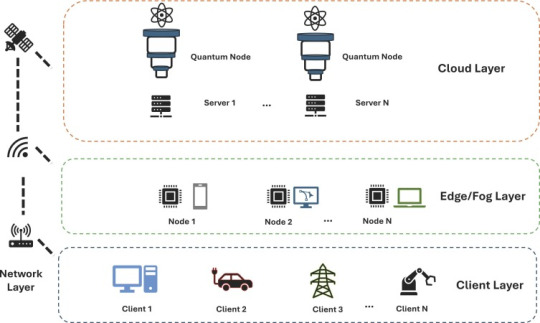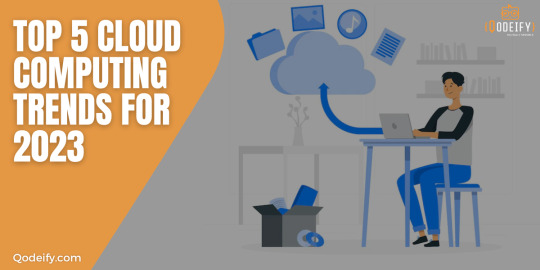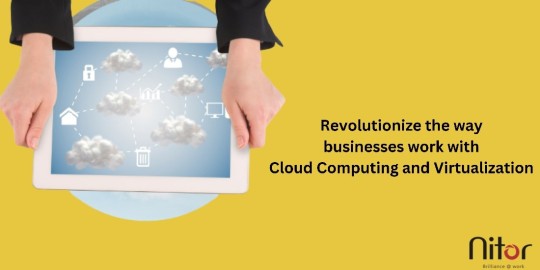#cloudcomputingtrends
Explore tagged Tumblr posts
Text
Top 7 Striking Cloud Computing Trends For Business Success In 2025
Cloud computing has been the talk of the industry for decades, improving business efficiency.
With new technological advancements, cloud computing has become more efficient and beneficial for growing businesses.
From AI taking charge to optimize cloud infrastructure to edge computing helping deliver fast responses, the cloud computing landscape is about to change in 2025.
In 2025, businesses will witness a cloud revolution and experience how new cloud trends will make a significant difference.
If you want to thrive in your respective niche, then considering these cloud trends will help you grow unexceptionally.
Let’s explore these top 7 cloud computing trends.
1. Artificial intelligence and Cloud
AI will change the entire landscape of how the cloud manages resources.
In 2025, AI will not be another service running on the cloud; it will optimize all cloud operations from ground to top level.
With advanced AI algorithms, the cloud will predict the resources required by providing real-time insights for resource allocation.
From automatic scaling to improving end-to-end security posture, cloud computing will offer a seamless experience.
If you are ready to embrace AI on top of the cloud, the results are extraordinary-
Unexceptional performance
Reduced unnecessary cost
Fewer human errors
More security, and
Efficient resource allocation
Optimized pricing models.
With leading AWS expertise, businesses can stay ahead by integrating AI at every step in cloud operations.
2. Edge Computing and Cloud
Edge computing is making strides and significant developments when combined with cloud computing.
It has made it possible to generate lightning-fast decisions by combining the computational power of edge computing while leveraging cloud-based intelligence.
Recently, we have seen how self-driving cars making an impact with their quick decision capabilities and cloud computing intelligence.
Not only the automotive industry, but edge computing is also changing healthcare with precise robotic surgery and deep learning capabilities of the cloud.
Combining these two technologies will help businesses to
Make decisions faster and more efficiently.
Offer smarter products and services that learn and adapt.
Provide better customer experiences.
Save costs and scale operations easily.
Improve security by keeping sensitive data local while still using the cloud for broader insights.
3. Quantum Computing becoming the mainstream
2025 is all about quantum computing. However, it has already started to find its way into real-world applications, especially cybersecurity.
Businesses might not be ready for heavy hardware investment but can leverage the power of quantum computing via cloud services.
Industries like IBM, Google, Microsoft, and Amazon the top cloud players are providing access to this quantum technology.
Today, most businesses are using it for advanced cybersecurity, drug discovery, and other cloud services.

Image Source: sciencedirect.com
Combining the cloud with Quantum computing helps businesses to
Analyze a larger set of data
Advanced security
Reduce the training time of ML and DL models, improving accuracy rates
Develop innovative solutions for complex applications.
4. Hybrid and Multi-Cloud Approach
The time has gone when businesses used to rely on a single cloud provider to optimize their operations.
Now, with the introduction of hybrid and multi-cloud approaches, businesses have come out of vendor lock-in challenges.
Today, more than 80% of businesses opt for a multi-cloud approach for better efficiency, and resilient cloud architecture that prepares businesses for any opportunity and challenge.
Also read- Why Businesses Adopt a Multi-cloud Strategy for Success?
5. Generative AI Improves Cloud Development
Generative AI is here to make developers smarter while reducing manual work and optimizing how they develop intelligent solutions. The same goes for the cloud development.
Gen AI powers developers to automate and streamline cloud-based solutions development.
Developers can generate and optimize codes while creating a seamless developing experience with personalized interfaces that align with their technical expertise.
By integrating generative AI into cloud platforms, businesses can create more innovative and intelligent applications, enhance user experiences, and improve operational efficiency, all while driving faster innovation in the tech industry.
Some popular Gen AI tools for cloud developers are-
AWS CodeWhisperer- AI-powered code suggestion tool designed specifically for developers building cloud applications on Amazon Web Services (AWS)
Azure OpenAI Service- allows developers to integrate OpenAI’s GPT models (like ChatGPT and Codex) into their cloud applications hosted on Microsoft Azure
Google Cloud AI and AutoML- offers various AI tools, including AutoML, which automates the creation of custom machine learning models for specific cloud applications without requiring deep expertise in AI.
6. Supercloud
After hybrid and multi-cloud, supercloud is another evolution in IaaS (Infrastructure as a Service).
It has made it possible for multi-cloud businesses to manage their data across different platforms.
With Supercloud a unified management layer, businesses can now openly choose multiple cloud vendors without worrying about their data syncing with each other.
It can also integrate edge computing to provide a unified infrastructure and user experience.

Image Source: f5.com
This abstraction layer allows businesses to access and govern the data across on-premises, public, and private clouds.
If you have large business data spread across regions, this trend is here to simplify your data complexity.
This approach provides businesses with service agreements with their chosen vendors.
It means businesses can reconfigure their infrastructure on the go through a supercloud interface to move services across platforms or servers in different locations.
Also read- Cloud Managed Services for Business Growth in 2025
7. Sustainability- Green Computing
Every business must know that implementing cloud computing can have a significant environmental cost, contributing to global greenhouse emissions.
Cloud computing and data centers account for about 1.8% of U.S. electricity consumption. This number would increase with the increase in cloud computing spending.
However, leaders like AWS and other cloud providers are taking the initiative for a 100% sustainable cloud approach by 2025, making it not just a trend but a growth opportunity for businesses to compete. Also, Google is ready to operate carbon-neutrally.
Are these Cloud Trends for You?
Well, it is the foremost question to ask yourself. Is your business strong enough to leverage these trends and benefit from them?
It might be possible that your business is not ready for the cloud revolution but it might be in 2025.
So, understanding these trends is necessary for you to get started. Consult with leading cloud development companies who will understand your business proposition to integrate the right trend at the right time before your business falls back.
For Content Source URL: Click Here
#CloudComputingTrends#CloudComputingServices#CloudComputingSolutions#CloudComputing#FutureTrendsinCloudComputing#Importanceofcloudcomputing
0 notes
Text
#Cloudcomputingtrends#Cloudbasedsystems#latesttrendsincloudcomputing#AIandMachineLearning#cloudITinfrastructure
0 notes
Text
1 note
·
View note
Text
Top 5 Cloud Computing Trends for 2023
When it comes to the future of cloud computing, we can safely assume that it will go through rapid changes. Here are the top 5 cloud computing trends for 2023.
Read More: Top 5 Cloud Computing Trends to Look Forward to in 2023

0 notes
Text
#cloudadoptiontrends#cloudcomputing#cloudcomputingapplication#cloudcomputinginformation#cloudcomputingtrends#cloudtechnology#integratedplatformasaservice#iPaaS#rannsolve#texas#trendingcloudtechnologies#trendsincloudcomputing#usa
0 notes
Link
As the cloud computing space is still new, there are several exciting developments that are happening at a rapid pace. Check the latest updates that took place in cloud computing.
0 notes
Link
0 notes
Photo

Read our blog to get knowledge about Trends of Cloud Computing. Consider those trends that may boom the upcoming year 2020.
Visit: http://bit.ly/37wTDLT to read our blog.
#elysiumpro#finalyearprojects#finalyearstudents#projectcenter#cloudcomputingtrends#trendsof2020#cloudcomputing#trends
0 notes
Link
Cloud computing and cloud storage have generated fundamental publicity and interest around the world. Every company needs cloud services in both frameworks to maintain their daily business operations. Companies realize the most significant benefits to cloud innovation, and however, many are clueless to its use. There is also the fear of cloud security at the time; however, with the expansion of time security layers in storage areas, companies have become more committed to using it.
0 notes
Link
#CloudComputingTrends#2018#Database#Technologies#DataStorage#MobileAppDevelopmentCompany#CloudStorage#CloudComputing#CloudSecurity#CloudServerHosting#CloudServicesSolutions#InternetOfThings#AppDevelopmentCompany#MobileApplicationDevelopmentCompanies#MobileAppDevelopmentCompanies#MobileApplication#AppDevelopment
0 notes
Text
Revolutionize the way businesses work with Cloud computing and Virtualization

Talking about today’s tech world, it is seen that cloud computing and virtualization are some of the trending technologies. You all may often get confused between these two and use them interchangeably. However, there are a few differences between the two. Allow me to elaborate.
Virtualization basically creates several simulated environments on one physical hardware system. Cloud computing, on the other hand, enables you as a user to access a shared platform of resources.
Cloud is used to extract, combine, and share resources across a network. You can also use cloud computing to run workloads within the cloud. It allows your business to access servers, databases, software, and other applications over the internet. Whereas virtualization is the software that is used to power cloud technology.
You will be able to find various features in cloud computing.
Cost saving
Scalability
Flexibility
Increased collaboration.
It helps you to make better decisions and in increasing innovations. Despite all these features it helps you to raise various concerns about data security and privacy.
Coming to virtualization, it helps to create a virtual version of computing resources. In cloud computing, it helps you to ensure smooth functioning of multiple operating systems. Because of this the systems can be easily provisioned, scaled and managed by users.
You can bring about a revolution in the way products are conceptualized, strategized, and developed by using cloud engineering. It is basically focused on building reliable, scalable, and secure cloud-based systems. Such systems help you to deliver a wide range of services and applications to the end user.
Difference between Cloud Computing and Virtualization
Cloud computing lets you access automated resources on-demand. Virtualization helps you create various stimulated environments through a physical hardware system. The setting up of cloud computing is difficult but it is more flexible and highly scalable. It is based on a pay-as-you-go model, offers unlimited storage space and is image-based.
While in virtualization, the set-up is simple, and it is less flexible. The pricing model is dependent on infrastructure costs and is template based. In virtualization, the storage capacity depends on the physical server.
Characteristics of Virtualization
The key characteristics of virtualization include:
Hardware independence: It enables software to run on any hardware platform.
Resource pooling: It allows multiple virtual machines to share the same physical resources.
Isolation: It provides an isolated environment for each virtual machine. It helps in preventing one virtual machine from affecting the performance of others.
Encapsulation: It allows an entire application to be encapsulated into a single file. Virtualization makes it easy to move, copy, or backup.
Dynamic provisioning: It enables resources to be dynamically allocated and de-allocated as needed.
Abstraction: It abstracts the underlying hardware. You can create and manage virtual machines as if they were physical machines.
Scalability: It ensures easy addition or removal of resources as needed.
Types of Virtualizations

Let’s look at the advantages of Virtualization in cloud computing.
Advantages of Virtualization
Reduces operation costs
Enhances flexibility
Improves security
Assigns applications and resources quickly
Increases business continuity and disaster recovery
Here you have all about Virtualization and cloud computing. Reach out to us at Nitor Infotech and share your views in the comments section.
4pillarsofcloudcomputing #cloudcomputing #cloudtechnology #cloudservices #cloudsecurity #cloudstorage #cloudnetworking #cloudcomputingexplained #cloudcomputingbasics #cloudcomputing101 #cloudcomputingarchitecture #cloudcomputingtrends #cloudcomputingnews #cloudcomputingbenefits #cloudcomputingstrategy #cloudcomputinginnovation #cloudcomputingfuture #cloudcomputingexpert #cloudcomputingindustry #cloudcomputingmanagement
0 notes
Text
Watch Out For These Top 5 Cloud Trends In 2021
2020 had been a year that saw offices operating from home and remote locations. This is not going to change anytime soon. Hence, today businesses need solutions that are cost-effective, scalable, and secure. Read more: https://qainfotech.com/top-5-cloud-computing-trends/ #CloudComputing #CloudTesting #CloudComputingTrends #BlogPost #TechnologyBlog

0 notes
Photo

#Manufacturing firms are adopting #cloudcomputing to increase productivity and accuracy in their operations.
#cloudcomputingtrends #manufacturingstats #manufacturingtrends #industry4
0 notes